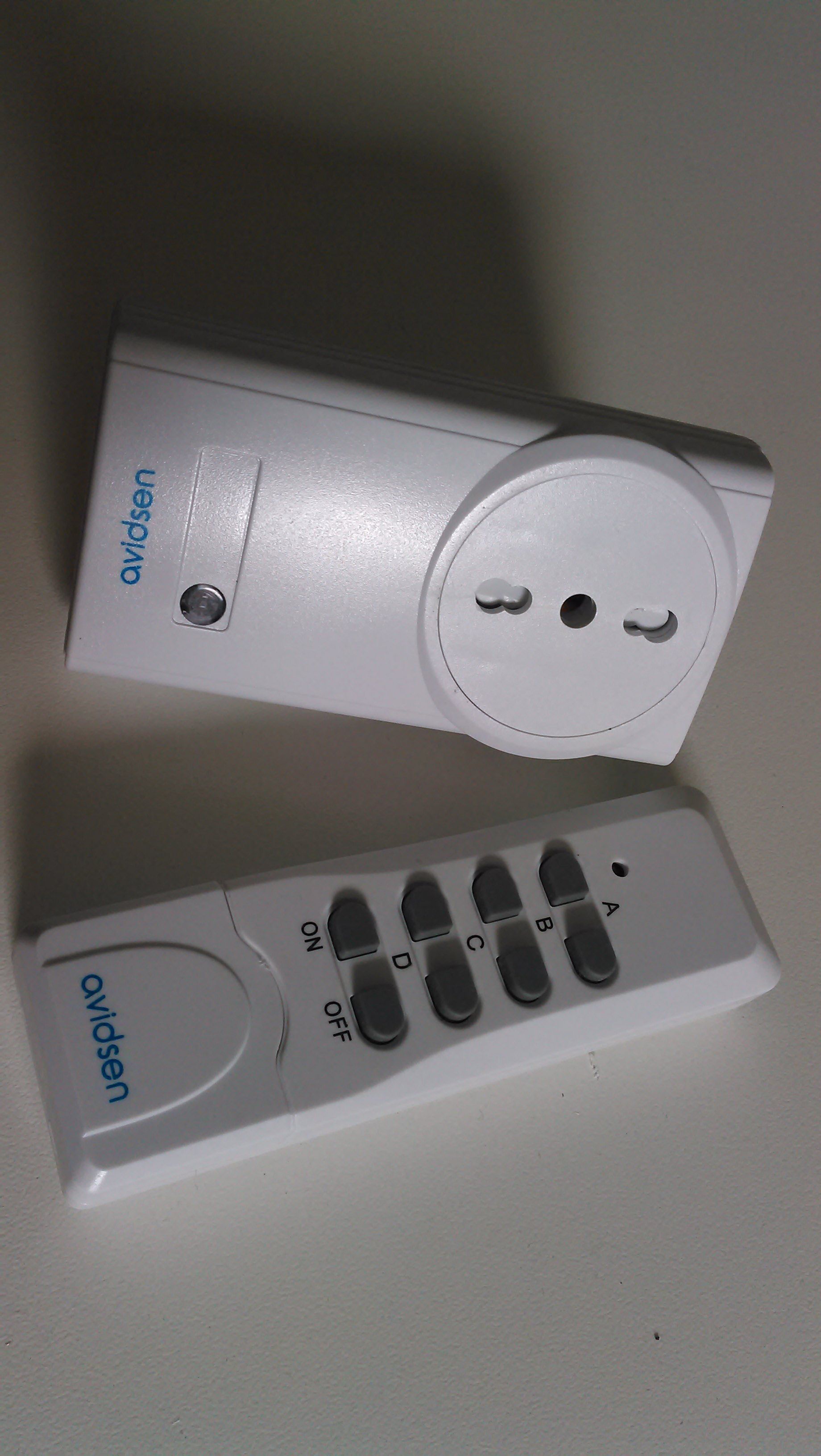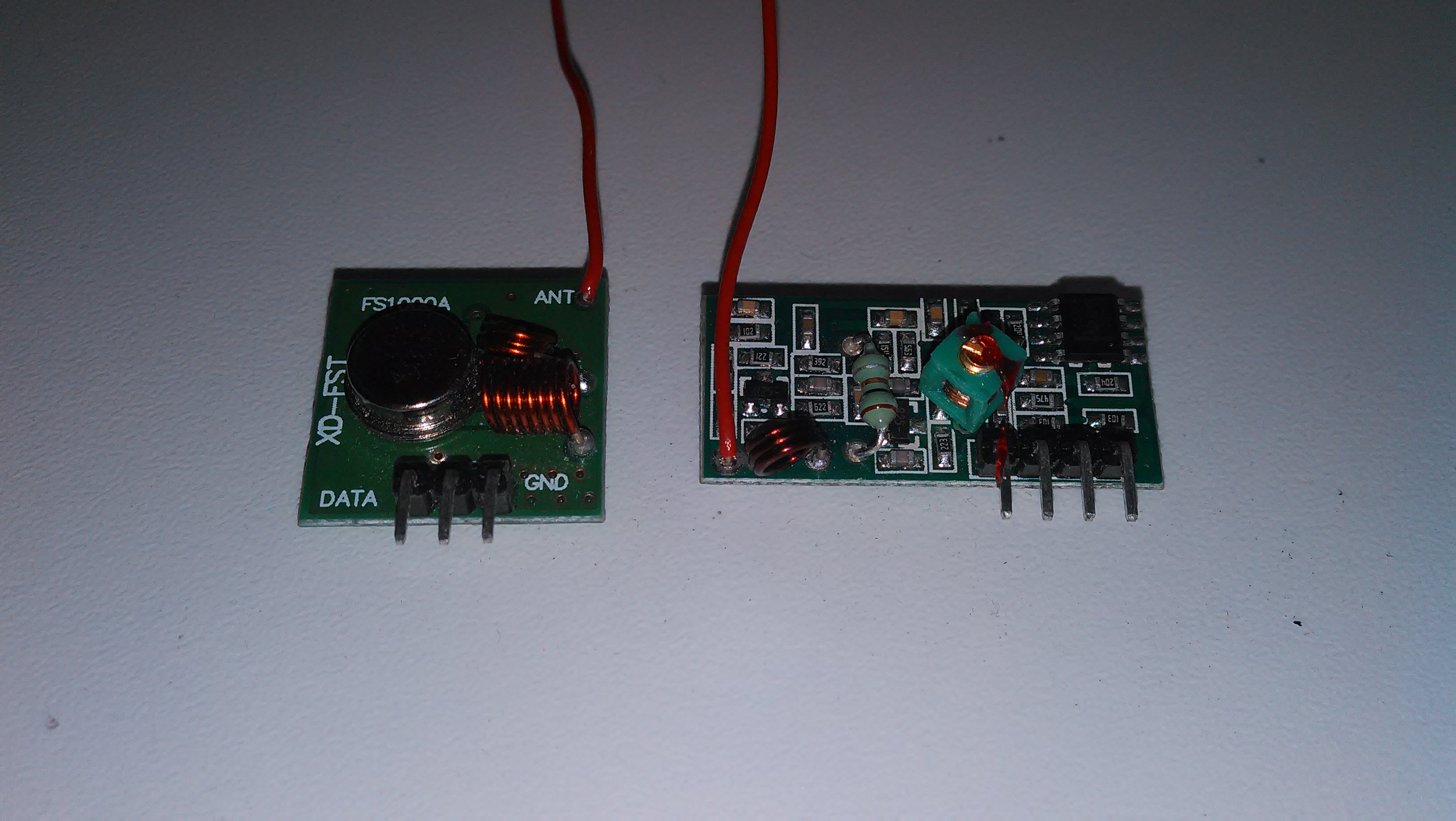Differenze tra le versioni di "Some experiments on Radio Remote Controls"
Jump to navigation
Jump to search
| Riga 16: | Riga 16: | ||
There is already a library named RC-Switch. It can be downloaded from github. | There is already a library named RC-Switch. It can be downloaded from github. | ||
This is its latest release: [https://github.com/sui77/rc-switch/releases/tag/v2.52 https://github.com/sui77/rc-switch/releases/tag/v2.52]. | This is its latest release: [https://github.com/sui77/rc-switch/releases/tag/v2.52 https://github.com/sui77/rc-switch/releases/tag/v2.52]. | ||
| + | |||
| + | The library includes a set a of examples. I have created a specific sketch for my avidsen set. | ||
| + | |||
| + | The wiring between the Arduino and TX/RX modules is: | ||
| + | <pre> | ||
| + | TX has three pins | ||
| + | (left to right watching the component side of the PCB, there are clear labels): | ||
| + | DATA <-> Arduino GPIO 2 | ||
| + | Vcc <-> Arduino 5v | ||
| + | GND <-> Arduino GND | ||
| + | |||
| + | RX has four pins | ||
| + | (left to right watching the component side of the PCB, the labels are printer on the reverse side of the PCB) | ||
| + | Vcc <-> Arduino 5v | ||
| + | DATA <-> Arduino GPIO 10 | ||
| + | DATA <-> (the two DATA pins are connected together, so either can be used). | ||
| + | GND <-> Arduino GND | ||
| + | </pre> | ||
| + | |||
| + | <source lang=c> | ||
| + | #include <RCSwitch.h> | ||
| + | |||
| + | RCSwitch mySwitch = RCSwitch(); | ||
| + | |||
| + | #define BINARY 0 | ||
| + | #define SWITCH 1 | ||
| + | int mode=SWITCH; | ||
| + | |||
| + | void setup() { | ||
| + | Serial.begin(115200); | ||
| + | mySwitch.enableReceive(0); // Receiver on inerrupt 0 => that is pin #2 | ||
| + | mySwitch.enableTransmit(10); | ||
| + | } | ||
| + | |||
| + | void incodeProcess(unsigned long code) { | ||
| + | static char outbuf[25]; | ||
| + | int i; | ||
| + | switch (mode) { | ||
| + | case BINARY: | ||
| + | for (i=0; i<24; i++, code>>=1) | ||
| + | outbuf[23-i] = (code & 1) ? '1' : '0'; | ||
| + | break; | ||
| + | case SWITCH: | ||
| + | outbuf[5]=outbuf[11]=' '; | ||
| + | outbuf[13]=0; | ||
| + | switch (code & 0xF) { | ||
| + | case 0x1: outbuf[12]='1';break; | ||
| + | case 0x4: outbuf[12]='0';break; | ||
| + | default: return; | ||
| + | } | ||
| + | code>>=4; | ||
| + | for (i=0; i<5; i++, code>>=2) | ||
| + | outbuf[10-i] = (code & 1) ? '0' : '1'; | ||
| + | for (i=0; i<5; i++, code>>=2) | ||
| + | outbuf[4-i] = (code & 1) ? '0' : '1'; | ||
| + | break; | ||
| + | } | ||
| + | Serial.print(outbuf); | ||
| + | Serial.println(); | ||
| + | } | ||
| + | |||
| + | void inlineProcess(char *line) { | ||
| + | if (line[5] == ' ' && line[11] == ' ' && line[13] == 0) { | ||
| + | line[5] = line[11] = 0; | ||
| + | switch (line[12]) { | ||
| + | case '1': | ||
| + | mySwitch.switchOn(line,line+6); | ||
| + | break; | ||
| + | case '0': | ||
| + | mySwitch.switchOff(line,line+6); | ||
| + | break; | ||
| + | default: | ||
| + | return; | ||
| + | } | ||
| + | } else | ||
| + | mySwitch.send(line); | ||
| + | } | ||
| + | |||
| + | void inbyte(int inchar) { | ||
| + | static char inbuf[64]; | ||
| + | static int pos=0; | ||
| + | if (inchar == '\r' || pos == 64) { | ||
| + | inbuf[pos]=0; | ||
| + | inlineProcess(inbuf); | ||
| + | pos=0; | ||
| + | } else if (inchar < ' ') { | ||
| + | switch (inchar) { | ||
| + | case 0x2: //ctrl-b | ||
| + | mode=BINARY; | ||
| + | break; | ||
| + | case 0x17: //ctrl-W | ||
| + | mode=SWITCH; | ||
| + | break; | ||
| + | } | ||
| + | } else | ||
| + | inbuf[pos++]=inchar; | ||
| + | } | ||
| + | |||
| + | void loop() { | ||
| + | if (mySwitch.available()) { | ||
| + | incodeProcess(mySwitch.getReceivedValue()); | ||
| + | mySwitch.resetAvailable(); | ||
| + | } | ||
| + | while (Serial.available()) { | ||
| + | inbyte(Serial.read()); | ||
| + | } | ||
| + | } | ||
| + | </source> | ||
Versione delle 16:12, 4 giu 2016
Arduino and Radio Controller Sockets
I have bought a kit by avidsen including a socket and a remote.
My goal was twice. I wanted to control avidsen sockets using an arduino and to get commands from a avidsen remote.
For that I have taken a set of RX and TX 433.92Mhz modules. This kind of modules are very common on e-bay.
They are usually provided without an antenna: they need a 17.3 cm wire soldered to the ANT labelled terminal.
There is already a library named RC-Switch. It can be downloaded from github. This is its latest release: https://github.com/sui77/rc-switch/releases/tag/v2.52.
The library includes a set a of examples. I have created a specific sketch for my avidsen set.
The wiring between the Arduino and TX/RX modules is:
TX has three pins (left to right watching the component side of the PCB, there are clear labels): DATA <-> Arduino GPIO 2 Vcc <-> Arduino 5v GND <-> Arduino GND RX has four pins (left to right watching the component side of the PCB, the labels are printer on the reverse side of the PCB) Vcc <-> Arduino 5v DATA <-> Arduino GPIO 10 DATA <-> (the two DATA pins are connected together, so either can be used). GND <-> Arduino GND
#include <RCSwitch.h>
RCSwitch mySwitch = RCSwitch();
#define BINARY 0
#define SWITCH 1
int mode=SWITCH;
void setup() {
Serial.begin(115200);
mySwitch.enableReceive(0); // Receiver on inerrupt 0 => that is pin #2
mySwitch.enableTransmit(10);
}
void incodeProcess(unsigned long code) {
static char outbuf[25];
int i;
switch (mode) {
case BINARY:
for (i=0; i<24; i++, code>>=1)
outbuf[23-i] = (code & 1) ? '1' : '0';
break;
case SWITCH:
outbuf[5]=outbuf[11]=' ';
outbuf[13]=0;
switch (code & 0xF) {
case 0x1: outbuf[12]='1';break;
case 0x4: outbuf[12]='0';break;
default: return;
}
code>>=4;
for (i=0; i<5; i++, code>>=2)
outbuf[10-i] = (code & 1) ? '0' : '1';
for (i=0; i<5; i++, code>>=2)
outbuf[4-i] = (code & 1) ? '0' : '1';
break;
}
Serial.print(outbuf);
Serial.println();
}
void inlineProcess(char *line) {
if (line[5] == ' ' && line[11] == ' ' && line[13] == 0) {
line[5] = line[11] = 0;
switch (line[12]) {
case '1':
mySwitch.switchOn(line,line+6);
break;
case '0':
mySwitch.switchOff(line,line+6);
break;
default:
return;
}
} else
mySwitch.send(line);
}
void inbyte(int inchar) {
static char inbuf[64];
static int pos=0;
if (inchar == '\r' || pos == 64) {
inbuf[pos]=0;
inlineProcess(inbuf);
pos=0;
} else if (inchar < ' ') {
switch (inchar) {
case 0x2: //ctrl-b
mode=BINARY;
break;
case 0x17: //ctrl-W
mode=SWITCH;
break;
}
} else
inbuf[pos++]=inchar;
}
void loop() {
if (mySwitch.available()) {
incodeProcess(mySwitch.getReceivedValue());
mySwitch.resetAvailable();
}
while (Serial.available()) {
inbyte(Serial.read());
}
}

